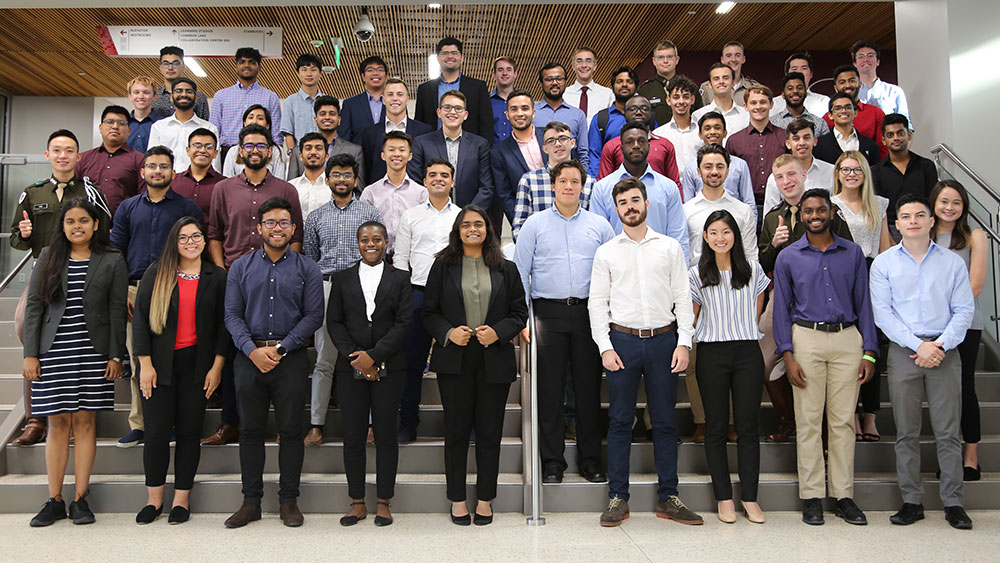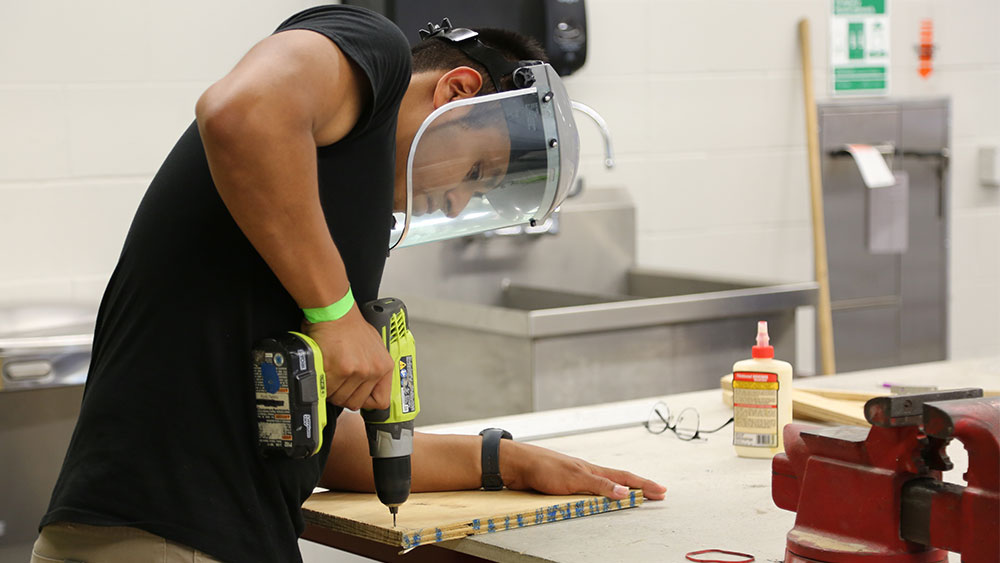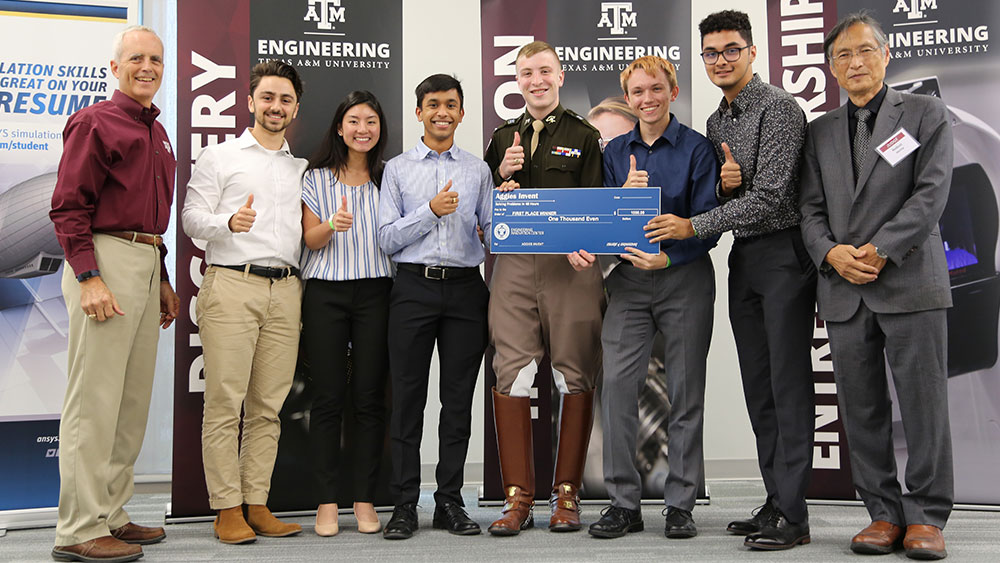
With only 48 hours on the clock, student teams participating in Aggies Invent: Energy Solutions took on real-world challenges facing industry that ranged from combating climate change to keeping the electricity on during natural disasters.
Sponsored by the Society of Petroleum Engineers and the Texas A&M Energy Club, Aggies Invent: Energy Solutions brought together students from across the College of Engineering to navigate the constantly evolving technologies that are reshaping people’s daily lives and seek solutions to power future generations. Their designs were presented to and judged by industry experts at the end of the make-a-thon.
“You learn a lot on my end about how to mentor students without giving them the answers,” said Sam Rogers, a wellsite leader at BP. “It’s just amazing, in a 48-hour period, watching them go from nothing to a prototype that may be feasible. It’s overwhelming, but it’s really empowering to see students doing that themselves.”
Jose Flores, a civil engineering senior with an Arabic Studies minor, explained that he was inspired to design a reliable means of powering refrigerators in developing countries after spending 10 weeks in Morocco learning the Arabic language.

“I experienced what it's like to live there, and propane was a big part of the living there because they would use it to warm their water and cook and do absolutely everything. So as soon as I saw the need statement, I thought you know, propane to produce electricity to run the refrigerators,” said Flores.
In response, his team created an attachment that would allow a refrigerator to have a power redundancy – keeping it working during power outages for up to eight hours so that food is properly stored with or without electricity.
Another team represented by Abdul Khan, an industrial distribution senior, tackled how to make cities more energy conservative.
“I'm actually a climate change minor and it’s something I have an avid interest in,” said Khan. “We thought (our need statement) was important because, as cities are growing, there's going to be more emissions from cars and people. So, we're making plans to reduce the amount of emissions from cars to decrease pollution.”
Aggies Invent: Energy Solutions photo gallery
We captured the intensity (and fun) during Aggies Invent: Energy Solutions. See for yourself!
“The 48-hour limit put us under pressure like we never experienced before,” said Taha Rahman, a general engineering sophomore and member of the winning team, Power Protected. “With a lot of us being underclassmen, it was a great opportunity for us to learn.”
The team also included general engineering freshmen Rudransh Dikshit and Tyler Calhoun, mechanical engineering sophomore Meghan Truong, nuclear engineering senior Trent Tutko and computer science and engineering sophomore Alex Soudah.
Together, they developed a means to provide households with sustainable energy when electric power grids are either damaged or compromised by a natural disaster – cutting families and companies off from a stable flow of electricity.
“The devastating effects of natural disasters are ample, including causing detrimental impact to electrical power grids,” said Tutko. “This impact will often times lead to thousands of individuals being without power, allowing for the potential of life-threatening situations to arise.”
Such as when Hurricane Harvey left over 300,000 individuals without power – including those on life-preserving machines in hospitals and homes.
Enter Power Protected, a microgrid that uses solar thermal panels to collect energy and store it in thermal batteries for when it is needed.
“Microgrids function as a safety net for small areas or buildings and they’re unique in that they can function independently from a failing main electric grid,” said Dikshit. “This is essential for areas effected by natural disasters because they are often cut off from the main electric grid.”

By storing energy until a disaster arises, Power Protected ensures that those effected will not be left in the dark.
“A backup generator is there in case of a disaster,” said Truong. “A microgrid is there 24/7, when there is not a disaster, and is storing energy and also feeding and supporting your main grid.”
Implemented mainly at disaster relief centers, the team’s design acts as a second path to power. As an electric power grid supplies energy to homes, Power Protected charges its thermal batteries with energy that is always at the ready. When the power grid goes down, Power Protected seamlessly takes over – making it so that the electricity never goes out in the building it is serving.
The second-place team, Lux Energy, included multidisciplinary engineering technology senior Jorge Roa, electrical engineering senior Patience Biyeh, mechanical engineering junior Sebastian Chirinos, mechanical engineering sophomore Noah Huerta, industrial and systems engineering junior Tuan Hoang, and biomedical engineering senior Brandon Look Fong. In order to provide sustainable energy to areas threatened by natural disasters, the team designed an “energy box” to provide illumination at night, communication abilities, and power for sanitation and medical operations. Their project, run off of solar power and packaged in a rectangular box, includes fold-out solar panels, a refrigeration unit and a chargeable battery.
The third-place team included petroleum engineering graduate student Mojoolaolu Malomo, petroleum engineering junior Xabier Palacios, electrical engineering graduate student Bharathikannan Gandhi, mechanical engineering graduate student Sai Raviteja Bhamidipati and petroleum engineering sophomore Nifemi Esan. Their project, Gas Finders, is designed to detect gas in the risers of offshore oil rigs. As such, it will reduce the risk of dangerous blowouts and explosive disasters and increase worker safety and environment protection.
Learn more about Engineering Entrepreneurship and the many programs it offers.